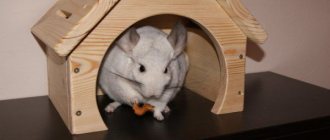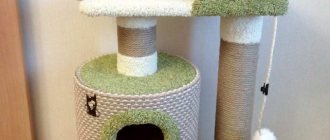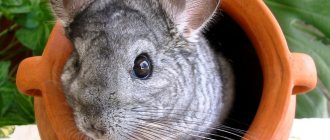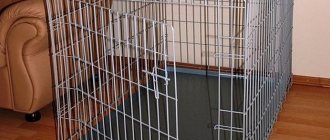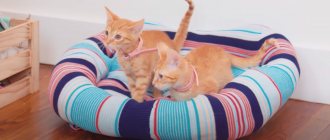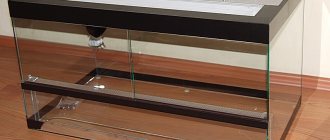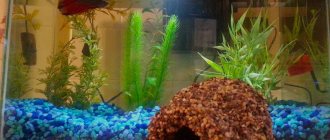/ Guinea pigs / Making a house for a guinea pig
0
1881
Article rating
It is known that guinea pigs are very sociable, they like to spend time with their owners and with other animals, but from time to time they require rest and solitude. A comfortable house for a guinea pig that will serve as protection and shelter is the first thing you should take care of when buying a pet.
Guinea pig house
Such a house, of course, can be purchased at any pet store, but by designing it yourself, you can not only save money, but also decorate it to your liking and invest a piece of your soul.
How to make a home for a guinea pig with your own hands
Pet stores sell various models of shelters for rodents, but they are expensive and may not always fit in size. If you make a house for a guinea pig with your own hands, it will cost the owner much less, and you can also choose the size and design to your liking.
Sleeping in a house is more comfortable than sleeping in an open space
The house can be made from various available materials: cardboard, wood, plastic, sewn from fabric or cut out of plywood. If there are several pigs, each of them needs a separate shelter.
Every pet needs its own corner
Important! Glass jars or aquariums should not be used as housing material - this can be dangerous to the life of your pet.
What to put in the house
Most likely, the pig will arrange a holiday home itself. You need to leave pieces of fabric or hay nearby, and the pet will drag the necessary materials to its nest. This is a personal space that the pet can independently arrange to his liking.
To be healthy, your pet needs a personal home. Having the opportunity to relax alone, the pet will feel calm, actively participate in games and communicate with the owner.
What should a good house be like?
House for a hamster - how to arrange it, choice of materials
Regardless of what material it is made of, in order for the pig’s house to be cozy and safe, the following conditions must be observed when creating it:
- The size of the house should be large enough for the rodent to rest comfortably in it in any position. The house for the baby should be made in advance in an “adult” size, or replaced in a timely manner as the pig grows.
- The diameter of the entrance hole should correspond to the size of the animal so that it does not have to squeeze into its own home.
- Safety is the most important factor: rodents taste everything, so the home is made of harmless materials and is not covered with paints or varnishes. The product must not contain screws, nails or other sharp parts.
- The roof must be level: pigs love to sit on their house, and falling on the sharp edge of the roof can lead to injury.
- You should not make your pet’s home too high: rodents are more comfortable in small burrows, and besides, it can be injured if it falls from above.
- To access fresh air you need to make one or more round windows.
- Some animals can relieve their natural needs in the house, so it is best to make its design collapsible or simply easy to clean.
Pigs love to sit on the roof
There is no need to put hay or other bedding inside. If the pig needs it, she will be able to drag it herself, but most often rodents are more comfortable sleeping on a clean floor.
Important! When the pig is in a shelter, it is not advisable to disturb it; the animal must be confident in the safety of its house.
Requirements for living conditions for pets
The standard for arranging a living space for one pet is a cage of 100x70 cm. A pair of pigs already needs 140x70 cm. A family of 3-4 rodents needs a free space of about 200x70 cm.
Before you begin creating a project or drawings for your future cage, it is worth taking into account important recommendations. It will also be useful to familiarize yourself with photos of models you have already made yourself:
- Choosing a location. The room must be clean, bright, dry. It is advisable that rodents do not feel isolated when they are in the far corner of the room. It will be better if the cage is located in a place where family members often gather.
- The floor under the cage must be absolutely level; it is not recommended to place it on a shaky or inclined surface.
- The height of the walls is at least 40 cm. A rodent standing on its hind legs should not reach the top of the wall.
- If you have other pets, such as a dog or cat, it is worth installing a ceiling to protect your guinea pigs from possible injury.
- The home of rodents should be naturally lit, located away from the outer walls of the room and heating devices, fans and air conditioners.
Attention! The bottom and walls of the cage should not be lattice to avoid injury to the rodents’ limbs.
Instructions for creating a wooden house
DIY cat house from a cardboard box
To create a wooden shelter, unpainted and unvarnished wood is used without any impregnation. The manufacturing process consists of several stages:
- Draw a drawing and determine the dimensions of the parts, as well as the diameter and location of the door and windows. The optimal housing shape is a rectangle with a flat roof.
- Transfer the patterns to wood or plywood and cut out the parts with a jigsaw.
- Carefully sand all elements until completely smooth.
- The pieces are joined with wood glue; it dries quickly and is non-toxic to animals. It is not recommended to use nails and screws - the pig will chew the house and could get hurt.
- Housing is ready. It should not be painted or pasted over: the main function of the craft is the comfort and safety of the pet, and not external beauty. If your pig eats paint or film, it can be harmful to its health.
Wooden housing - cozy and environmentally friendly
If you make a structure without a floor, this will make cleaning easier and help you get your pet out in an emergency: for example, for treatment, or if the animal stole something harmful to itself and took it into a hole.
Necessary materials
- Multilayer and dense corrugated cardboard,
- Metal mesh or lattice with a mesh no larger than three centimeters,
- Ordinary plastic cable ties,
- Knife,
- Scotch tape,
- Large and small scissors
- Pencils or markers for marking,
- Ruler.
To ensure that the cardboard does not allow moisture to pass through, it must be glued on the inside with tape in two or three layers. Some people prefer to cover the inside with acrylic or even fiberglass. Cardboard is an ideal material - it is light, easy to work with, odorless and harmless, and also easy to find.
Prepare the necessary materials and tools:
- ruler;
- stationery knife;
- small and large scissors;
- markers and pencils for marking;
- plastic clamps;
- scotch;
- metal grid with a cell size of up to 3 cm;
- thick cardboard.
It is recommended to install a plastic tray at the bottom of the structure, which will facilitate the cleaning process and protect the animals from drafts. An alternative option is a pallet made of 8 mm plywood; for this, use the base drawing. The ends of the walls and bottom are glued together with toxic-safe glue. You can also make a pallet from polycarbonate by connecting the structural elements with building corners.
Instructions for creating a house from a box or cardboard
How to make a house for a cat with your own hands: patterns
It’s the fastest way to make a home from a cardboard box: you just need to cut holes in it for entry and ventilation and place it in the cage upside down. If there is a need to connect parts, it is best to sew them with thick thread. Chewing tape or glue is not good for animals.
Laminated or glossy boxes are not suitable for creating houses.
Shelter from a cardboard box
A house made from cardboard containers is easy and quick to make, but it should be taken into account that such a house is not durable: cardboard easily gets wet and absorbs unpleasant odors, so the boxes should be periodically replaced with new ones.
Important! Do not use boxes of household chemicals - this can lead to allergies in the animal.
Advantages of arranging a homemade cage
Some breeders believe that the advice to make a cage no longer has any scientific basis. However, the large area of the cage will allow the animal to move actively and not get bored even when the breeder does not have enough time to let the animal walk around the apartment. In the cage-aviary, the pig can play, run, explore the territory and even just go eat - it will take her time.
Movement is a good prevention of diseases of the lungs, heart, kidneys, and stomach. A large cage will also allow each pig to have its own corner and its own zone of comfort and relaxation. This means fights between animals will stop. The area of the pig's house also plays an important role when the female is expecting offspring or already has offspring.
A larger cage is easier to keep clean. It is much more convenient to clean, change food and bedding. Watching animals frolicking in an enclosure is also much more convenient and interesting.
Instructions for creating a plastic house
This house is made from an opaque container made of food-grade plastic, in which doors and windows are cut with a sharp knife. The edges of the cuts are sanded with fine sandpaper until completely smooth. Food trays that are sold at Fix Price are well suited for creating such shelters.
The advantage of plastic houses is that they are simple to make and easy to clean, but the main disadvantage is that the material is not environmentally friendly. Plastic, unlike wood or cardboard, can accumulate unpleasant odors inside the home.
Plastic house
Cozy holes that pigs love can also be made from plastic water pipes (new ones, of course). But it should be borne in mind that non-food grade plastic is dangerous for animals, and this option is only suitable for those animals that definitely will not try it.
Stages of assembling a pet's home
It is important to clearly follow the step-by-step steps so that the final result pleases you. Namely:
- you need to cut four equal-sized squares from the prepared plywood; after this, in one of the squares it is necessary to cut the entrance door, as already mentioned, in the form of an arch. Determine its size based on the size of the pet; fasten all the finished elements together with nails or staples, but so that the animal does not get hurt when it is inside; Next, using slats, you need to construct a roof. Cut their edges at an angle of 45 degrees; then connect them and attach them to our “apartment”; use your imagination and cover the slats with colored paper, fabric or plywood.
Such a wooden house will serve your “little pig” for a very long time. It will be reliable, strong, and most importantly - cozy. Besides all this, a wooden dwelling is perfect for a rodent to grind down its teeth. After all, small animals always like to chew something, and wood is an excellent helper in this case.
Instructions for creating a fabric house
A fabric house is more difficult to make, and this material, like cardboard, absorbs moisture and odors, but the main advantage of such a craft is softness and warmth. For older pigs or for the cold season, rag housing will be the best option.
A simple shelter made from old jeans
The simplest design of a fabric house is a double-sided bag. For the outside, a trouser leg from old jeans or thick material is used; the inside is made of soft fabric like fleece.
Two bags measuring approximately 30x20 cm are sewn from both materials, inserted one into the other and sewn together along the edge. You can attach strings to the corners of the product to tie it to the bars of the cage.
Adviсe
So, what you need to consider:
- The cage must be equipped with everything necessary, otherwise the pet will not feel comfortable.
- For the bottom, use corrugated cardboard, plastic or other durable material that the pig cannot chew through.
- The iron for the grill must be as strong as possible, otherwise your pet will chew through it without any problems.
- Clean the cage regularly to prevent bacteria and disease.
- The cage must be made in such a way that it can be disassembled and washed without any problems; take this into account when assembling.
- The larger the space, the more comfortable the animal is.
- The air temperature in the room where the rodent is kept should be around 22 degrees. It shouldn't be too hot or cold here.
Two-story design
To keep several pets, you can build two-story or multi-tier structures. The good thing about the two-story design is that you can separate the seating area and the food area. Multi-tiered structures can be equipped to accommodate several pets. In this case, assign each ward a tier. At the same time, each guinea pig should have its own drinking bowl and feeding trough, and a sleeping house.
Two-story and multi-tier structures are built by analogy with one-story ones. First of all, we create a drawing. When creating a drawing, you can look at pictures of cells offered, for example, by such a well-known company as ferplast. But, they are all of the same type, and are a rectangular structure of small sizes, similar to those for keeping guinea pigs, divided into floors. You need to equip the structure yourself. After installing the sleeping house, feeding trough, hay barn and drinking bowl, there is very little free space left, which does not allow the pet to lead an active lifestyle. Therefore, it is advisable to use your imagination when creating a drawing.
When arranging a two-story structure, cover the second floor with bedding. In principle, you can use any soft fabric, but the best bedding is a PVC mat.
Video “Pig Cage”
A version of a large enclosure with a pen for a guinea pig is presented in the video.
Was this article helpful?
Thank you for your opinion!
The article was useful. Please share the information with your friends.
Yes (100.00%)
No
X
Please write what is wrong and leave recommendations on the article
Cancel reply
Rate the benefit of the article: Rate the author ( 7 votes, average: 4.43 out of 5)
Discuss the article:
